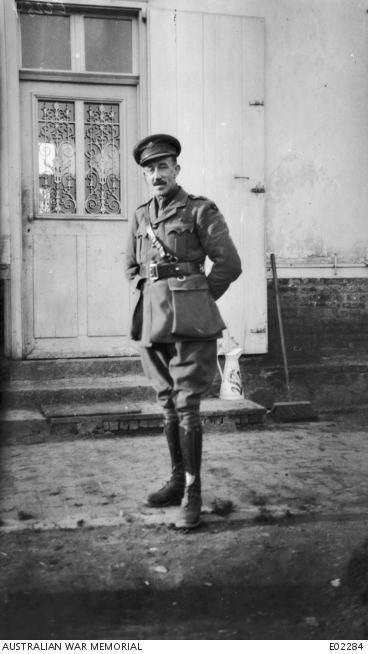Years of service 1899–1931 Rank Brigadier general | Died October 24, 1955 Name Henry Goddard | |
 | ||
Battles/wars World War IGallipoli CampaignWestern FrontBattle of the Somme Awards Companion of the Order of St Michael and St GeorgeDistinguished Service OrderMention in Despatches (3)Croix de Guerre (Belgium) Battles and wars Gallipoli Campaign, Western Front, Operation Michael, World War I | ||
Henry Arthur Goddard CMG, DSO (13 December 1869 – 24 October 1955) was an Australian Army colonel and temporary Brigadier General in World War I. He retired as a brigadier general in 1931.
Contents
Early life and career
Henry Arthur Goddard was born in West Hackney, Middlesex, England on 13 December 1869, the son of an insurance clerk. Goddard migrated to Australia in 1890. He settled in Brisbane where he worked as a clerk. He experimented with growing barley on the Darling Downs. He was also consul for Paraguay from 1906 to 1915.
In England, Goddard had been a sergeant in the Essex Rifle Volunteers. On 30 November 1899 he was commissioned as a lieutenant in the Moreton Regiment. On 11 February 1913 he was promoted to lieutenant and given command of the regiment. On his many business trips overseas he observed military manoeuvres in Europe.
World War I
When war was declared 1914, Goddard was placed in charge of the Brisbane Defences. On 16 March 1915 he was appointed to the First Australian Imperial Force with the rank of lieutenant colonel and given command of the 25th Infantry Battalion. He expected to take this battalion overseas but on 9 May 1915 he was suddenly ordered to take over command of the 17th Infantry Battalion, which was about to sail for Egypt. Goddard considered it a great blow to have to leave the battalion that he had built up, and a definite setback to his career. He took charges of the 17th Infantry Battalion on 12 May, on board the transport Themistocles.
The 17th Infantry Battalion arrived in Egypt on 12 June 1915 where it trained until ordered forward to Anzac Cove, departed for Gallipoli on 16 August 1915. It left without Goddard, who was hospitalised with intestinal poisoning. He managed to get himself cleared by the medical authorities and departed on the next available ship, the Southland, which was torpedoed en route on 2 September 1915. Goddard finally made it Anzac on 6 September 1915, taking over command of the 17th Infantry Battalion. That day, he took over command of Quinn's Post, the most exposed and one of the most dangerous position on the line. He remained in command of Quinn's Post until Anzac was evacuated on 20 December 1915. Goddard was in command of the last party there and departed the post at 2:35am.
The 17th Infantry arrived at Lemnos on 20 November 1915, and Alexandria on 4 January 1916. It proceeded to Tel El Kebir four days later. Goddard had managed to remain in the line at Gallipoli only by ignoring a serious case of dysentery. Now he was admitted to hospital on 18 January 1916. On 10 April 1916, he was evacuated to Australia, returning on 18 May 1916.
Cleared by the medical board, Goddard travelled to Sydney on 16 July 1916 to rejoin the AIF. On 1 August 1916 he sailed from Melbourne on board HMAT Miltiades, a troop transport. Reporting to AIF Headquarters in London on 26 September 1916, he was on 13 October 1916 once again given command of a New South Wales battalion preparing to embark, the 35th Infantry Battalion, part of the new 3rd Division, training on the Salisbury Plain in England. The battalion arrived in France on 22 November 1916.
Goddard led the 35th Infantry Battalion at Messines, Broodeseinde and Passchendaele. For his part, Goddard was mentioned in dispatches and awarded the Distinguished Service Order (DSO) in the 1918 New Year's List. He was acting commander of the 9th Infantry Brigade for short periods in May, August and October 1917 and for over a month from 5 January 1918 to 18 February 1918.
On 3 April 1918, Brigadier General Rosenthal placed Goddard in command of all troops at Villers-Bretonneux, where he established his headquarters. The next morning the Germans attacked his force. A full-scale battle developed, the First Battle of Villers-Bretonneux controlled by Goddard, who acted almost as a brigade commander. For this battle, Goddard was again mentioned in dispatches.
At the Battle of Morlancourt on 5 May 1918, Rosenthal once again placed Goddard in command of the main operation. Then on 21 May 1918, Goddard took over as commander of the 9th Infantry Brigade. On 1 June 1918 he was promoted to full colonel and temporary brigadier general. He led the brigade at Bray-sur-Somme and the attack on the Hindenburg Line. For these battles, Goddard was mentioned in dispatches once more and made a Companion of the Order of St Michael and St George (CMG) in the 1919 New Year's list.
Post war
Goddard moved to Sydney after the war where he pursued his business and military interests. He commanded the 14th Infantry Brigade from 1921 to 1926 and was honorary colonel of the 17th Infantry Battalion. He was placed on the retired list in 1931 with the rank of brigadier general.
Goddard ran an importing company, H. A. Goddard Pty Ltd with his son Horace, who had served as a private in the 35th Infantry Battalion during the war. Goddard continued to travel, and was commercial representative of The Times in Australia. He died at the Concord Repatriation Hospital in Sydney on 24 October 1955 and was cremated.
